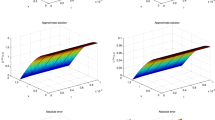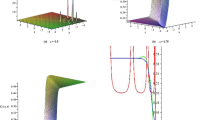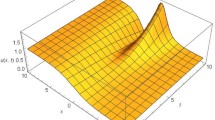Abstract
Nonlinear phenomena play an essential role in various field of natural sciences and engineering. In particular, the nonlinear chemical reactions are observed in various domains, as, for instance, in biological and chemical physics. For this reason, it is important to investigate the solution to this nonlinear phenomenon. This article investigates numerical solutions to a nonlinear oscillatory system called the Belousov–Zhabotinsky with Caputo fractional-time derivative. The simplified Noyes–Field fractional model reads
where \(\xi _1\) and \(\xi _2\) are the diffusing constants for the concentration p and w respectively, \(\gamma \) and \(\beta \) are given constants, \(\lambda \ne 1\) and \(\delta \) are positive parameters. The two iterative techniques used in this work are the fractional reduced differential transform method and q-homotopy analysis transform method. The outcomes using these two methods reveal an efficient numerical solution with high accuracy and minimal computations. Furthermore, to better understand the effect of the fractional order, we present the solution profiles which demonstrate the behavior of the obtained results.











Similar content being viewed by others
References
Abedle-Rady AS, Rida SZ, Arafa AAM, Adedl-Rahim HR (2014) Approximate analytical solutions of the fractional nonlinear dispersive equations using homotopy perturbation Sumudu transform method. Int J Innov Sci Eng Technol 1(9):257–267
Adomian G (1994) Solving Frontier problems of physics: the decomposition method. Kluwer, New York
Akinyemi L (2019) q-Homotopy analysis method for solving the seventh-order time-fractional Lax’s Korteweg–de Vries and Sawada–Kotera equations. Comput Appl Math 38(4):1–22
Akinyemi L, Iyiola OS (2020) A reliable technique to study nonlinear time-fractional coupled Korteweg–de Vries equations. Adv Differ Equ 169:1–27. https://doi.org/10.1186/s13662-020-02625-w
Akinyemi L, Iyiola OS, Akpan U (2020) Iterative methods for solving fourth- and sixth order time-fractional Cahn–Hillard equation. Math Methods Appl Sci 43(7):4050–4074. https://doi.org/10.1002/mma.6173
Ali M, Alquran M, Jaradat I (2019) Asymptotic-sequentially solution style for the generalized Caputo time-fractional Newell–Whitehead–Segel system. Adv Differ Equ 2019:1–9
Alquran M, Al-Khaled K, Chattopadhyay J (2015) Analytical solutions of fractional population diffusion model: residual power series. Nonlinear Stud. 22(1):31–9
Baleanu D, Guvenc ZB, Machado JT (2010) New trends in nanotechnology and fractional calculus applications. Springer, New York
Baleanu D, Machado JAT, Luo AC (2011) Fract Dyn Control. Springer Science and Business Media, New York
Baleanu D, Wu GC, Zeng SD (2017) Chaos analysis and asymptotic stability of generalized Caputo fractional differential equations. Chaos Solitons Fract 102:99–105
Caputo M (1969) Elasticita e dissipazione. Zanichelli, Bologna
Das S (2009) Analytical solution of a fractional diffusion equation by variational iteration method. Comput Math Appl 57:483–487
El-Tawil MA, Huseen SN (2012) The Q-homotopy analysis method (q-HAM). Int J Appl Math Mech 8(15):51–75
El-Tawil MA, Huseen SN (2013) On convergence of the q-homotopy analysis method. Int J Contemp Math Sci 8:481–497
Eltayeb H, Kilicman A (2012) Application of Sumudu decomposition method to solve nonlinear system of partial differential equations. Abstr Appl Anal 2012:1–13
Fisher RA (1937) The wave of advance of advantageous genes. Ann Eugen 7(4):355–369
Gibbs RG (1980) Traveling waves in the Belousov–Zhabotinskii reaction. SIAM J Appl Math 38(3):422–444
He JH (1998) Approximate analytical solution for seepage flow with fractional derivatives in porous media. Comput Methods Appl Mech Eng 167:57–68
He JH (1999) Homotopy perturbation technique. Comput Methods Appl Mech Eng 178:257–62
He JH (2003) Homotopy perturbation method: a new nonlinear analytical technique. Appl Math Comput 135:73–9
Hilfer R, Anton L (1995) Fractional master equations and fractal time random walks. Phys Rev E 51:R848–R851
Iyiola OS (2015) On the solutions of non-linear time-fractional gas dynamic equations: an analytical approach. Int J Pure Appl Math 98(4):491–502
Iyiola OS (2016) Exact and approximate solutions of fractional diffusion equations with fractional reaction terms. Progr Fract Differ Appl 2(1):21–30
Iyiola OS, Soh ME, Enyi CD (2013) Generalised homotopy analysis method (q-HAM) for solving foam drainage equation of time fractional type. Math Eng Sci Aerosp 4(4):105
Jaradat A, Noorani MSM, Alquran M, Jaradat HM (2018a) Numerical investigations for time-fractional nonlinear model arise in physics. Results Phys 8:1034–1037
Jaradat I, Alquran M, Abdel-Muhsen R (2018b) An analytical framework of 2D diffusion, wave-like, telegraph, and Burgers’ models with twofold Caputo derivatives ordering. Nonlinear Dyn 93(4):1911–1922
Jaradat I, Alquran M, Al-Khaled K (2018c) An analytical study of physical models with inherited temporal and spatial memory. Eur Phys J Plus 133:1–11
Joseph K (2012) Fractional dynamics: recent advances. World Scientific, Singapore
Keskin Y, Oturanc G (2010) Reduced differential transform method: a new approach to fractional partial differential equations. Nonlinear Sci Lett A 1:61–72
Khuri SA (2001) A Laplace decomposition algorithm applied to class of nonlinear differential equations. J Math Appl 1(4):141–155
Kilbas AA, Srivastava HM, Trujillo JJ (2006) Theory and applications of fractional differential equations, vol 204. Elsevier Science B.V., Amsterdam
Kumara D, Singha J, Baleanu D (2017) A new analysis for fractional model of regularized long-wave equation arising in ion acoustic plasma waves. Math Methods Appl Sci 40:5642–5653
Kumar D, Seadawy AR, Joardar AK (2018a) Modified Kudryashov method via new exact solutions for some conformable fractional differential equations arising in mathematical biology. Chin J Phys 56(1):75–85
Kumar D, Singh J, Baleanu D (2018b) A new numerical algorithm for fractional Fitzhugh–Nagumo equation arising in transmission of nerve impulses. Nonlinear Dyn 91:307–317
Kurt A, Rezazadeh H, Şenol M, Neirameh A, Tasbozan O, Eslami M, Mirzazadeh M (2019) Two effective approaches for solving fractional generalized Hirota–Satsuma coupled KdV system arising in interaction of long waves. J Ocean Eng Sci 4(1):24–32
Laskin N, Zaslavsky G (2006) Nonlinear fractional dynamics on a lattice with long range interactions. Phys A Stat Mech Appl 368(1):38–54
Liao SJ (1995) An approximate solution technique not depending on small parameters: a special example. Int J Nonlinear Mech 30(3):371–380
Liao SJ (1998) Homotopy analysis method: a new analytic method for nonlinear problems. Appl Math Mech 19:957–962
Liao SJ (2004) On the homotopy analysis method for nonlinear problems. Appl Math Comput 147(2):499–513
Luchko YF, Srivastava HM (1995) The exact solution of certain differential equations of fractional order by using operational calculus. Comput Math Appl 29:73–85
Mainardi F (2010) Fractional calculus and waves in linear viscoelasticity. Imperial College Press, London
Miller KS, Ross B (1993) An introduction to fractional calculus and fractional differential equations. Wiley, New York
Nasrolahpour H (2013) A note on fractional electrodynamics. Commun Nonlinear Sci Numer Simul 18:2589–2593
Podlubny I (1999) Fractional differential equations. Academic Press, New York
Pu YF (2007) Fractional differential analysis for texture of digital image. J Algorithm Comput Technol 1(3):357–380
Ray SS, Bera RK (2006) Analytical solution of a fractional diffusion equation by Adomian decomposition method. Appl Math Comput 174(1):329–336
Şenol M, Iyiola OS, Daei Kasmaei H, Akinyemi L (2019a) Efficient analytical techniques for solving time-fractional nonlinear coupled Jaulent–Miodek system with energy-dependent Schrödinger potential. Adv Differ Equ 2019:1–21
Şenol M, Tasbozan O, Kurt A (2019b) Numerical solutions of fractional Burgers’ type equations with conformable derivative. Chin J Phys 58:75–84
Singh J, Kumar D, Baleanu D, Rathore S (2018) An efficient numerical algorithm for the fractional Drinfeld–Sokolov–Wilson equation. Appl Math Comput 335:12–24
Soh ME, Enyi CD, Iyiola OS, Audu JD (2014) Approximate analytical solutions of strongly nonlinear fractional BBM-Burger’s equations with dissipative term. Appl Math Sci 8(155):7715–7726
Sun HG, Zhang Y, Baleanu D, Chen W, Chen YQ (2018) A new collection of real world applications of fractional calculus in science and engineering. Commun Nonlinear Sci Numer Simul 64:213–231
Sweilam NH, Hasan MMA, Baleanu D (2017) New studies for general fractional financial models of awareness and trial advertising decisions. Chaos Solitons Fract 104:772–784
Tarasov VE (2006) Gravitational field of fractal distribution of particles. Celest Mech Dyn Astron 94(1):1–15
Ullah A, Chen W, Sun HG, Khan MA (2017) An efficient variational method for restoring images with combined additive and multiplicative noise. Int J Appl Comput Math 3(3):1999–2019
Veeresha P, Prakasha DG, Baskonus HM (2019) Novel simulations to the time-fractional Fisher’s equation. Math Sci 13(1):33–42
Wazwaz AM, Gorguis A (2004) An analytic study of Fisher’s equation by using Adomian decomposition method. Appl Math Comput 154:609–620
Zhabotinsky Anatol M (2007) Scholarpedia 2(9):1435. https://doi.org/10.4249/scholarpedia
Zhang Y, Pu YF, Hu JR, Zhou JL (2012) A class of fractional-order variational image in-painting models. Appl Math Inf Sci 6(2):299–306
Author information
Authors and Affiliations
Corresponding author
Additional information
Communicated by Agnieszka Malinowska.
Publisher's Note
Springer Nature remains neutral with regard to jurisdictional claims in published maps and institutional affiliations.
Rights and permissions
About this article
Cite this article
Akinyemi, L. A fractional analysis of Noyes–Field model for the nonlinear Belousov–Zhabotinsky reaction. Comp. Appl. Math. 39, 175 (2020). https://doi.org/10.1007/s40314-020-01212-9
Received:
Revised:
Accepted:
Published:
DOI: https://doi.org/10.1007/s40314-020-01212-9
Keywords
- Belousov–Zhabotinsky system
- q-Homotopy analysis transform method
- Laplace transform
- Fractional reduced differential transform method
- Fractional Fisher’s equation




